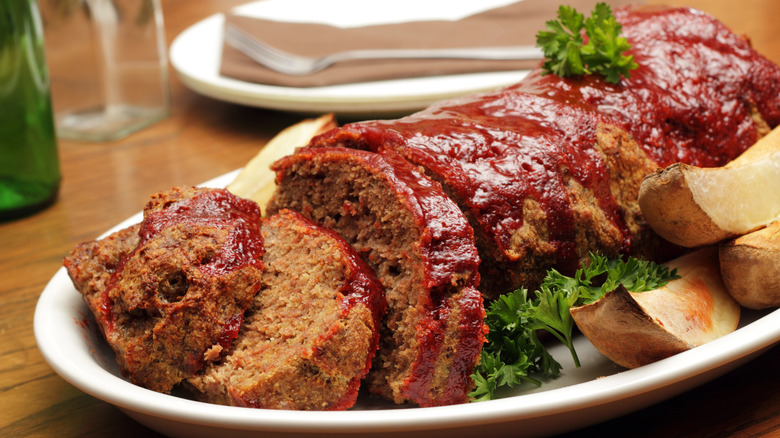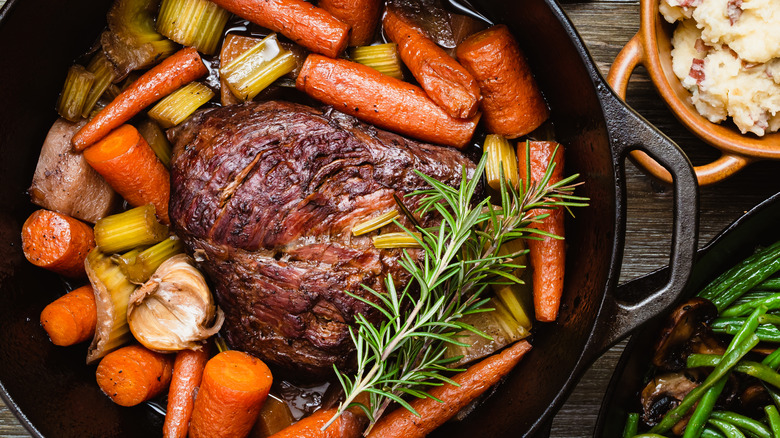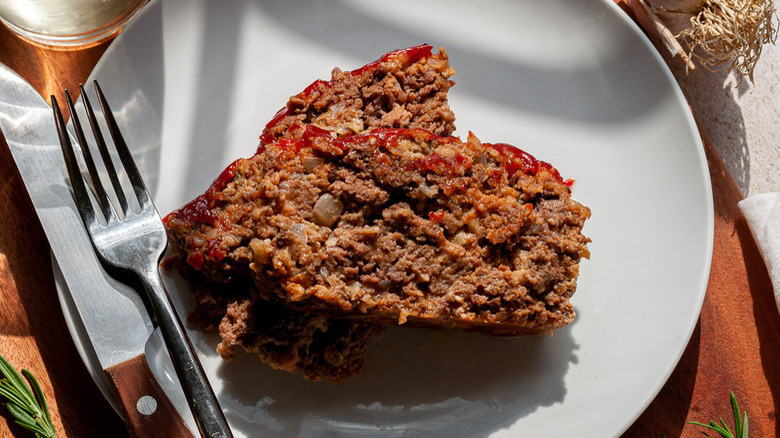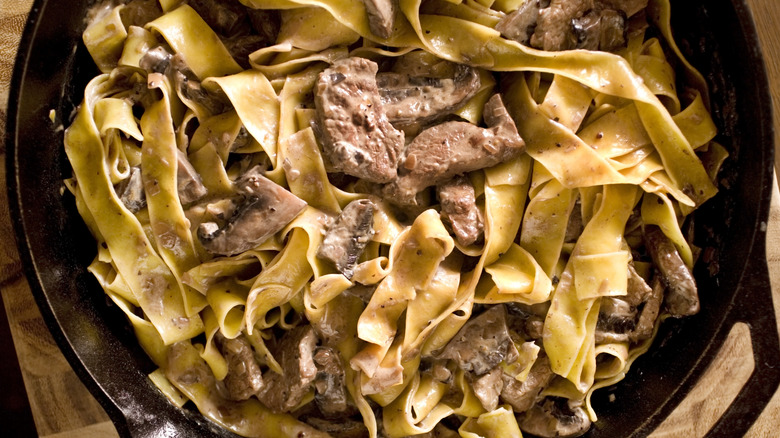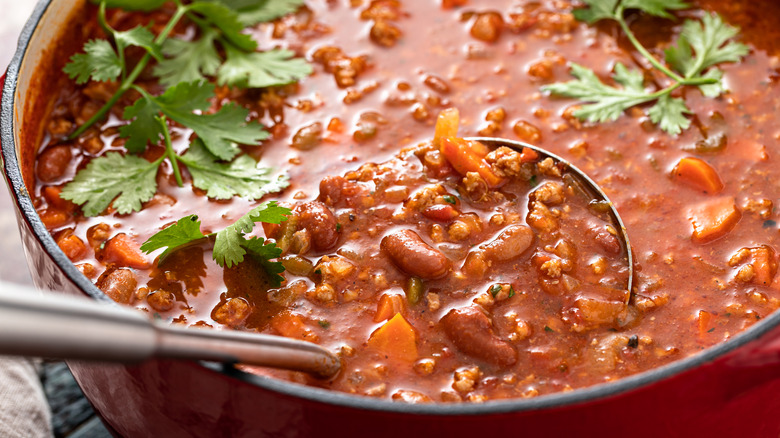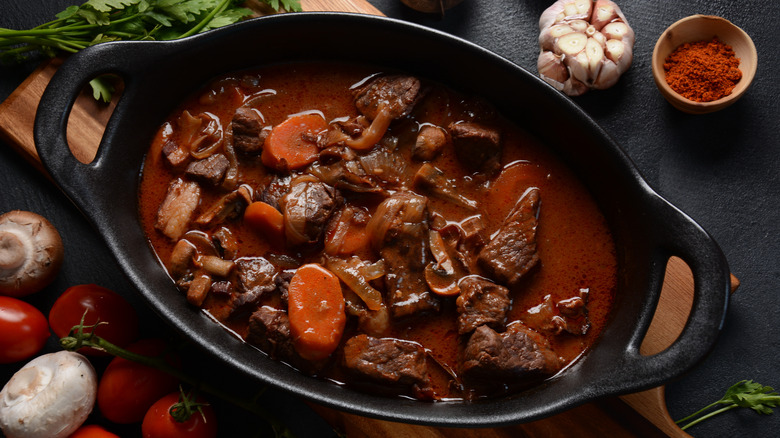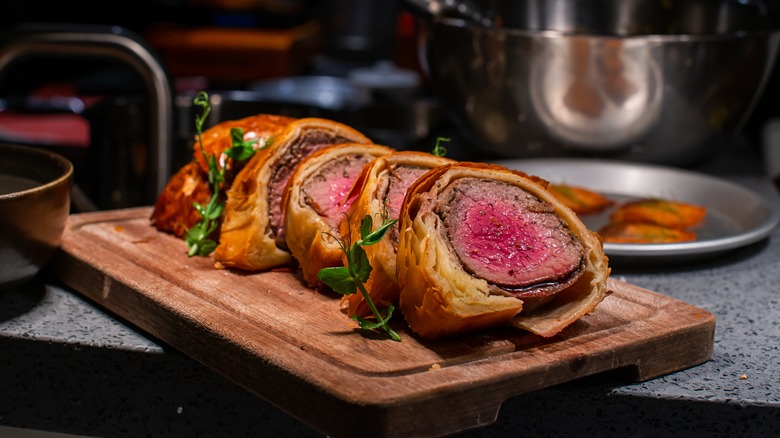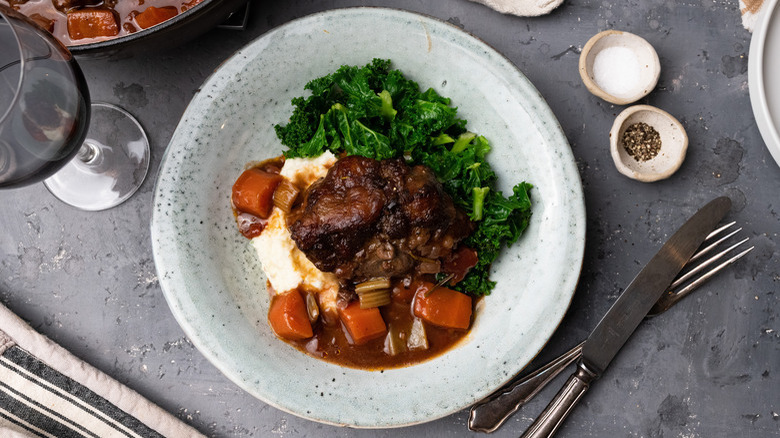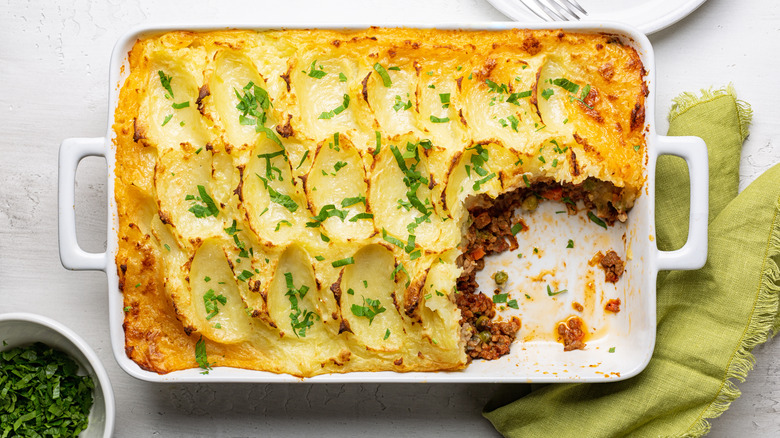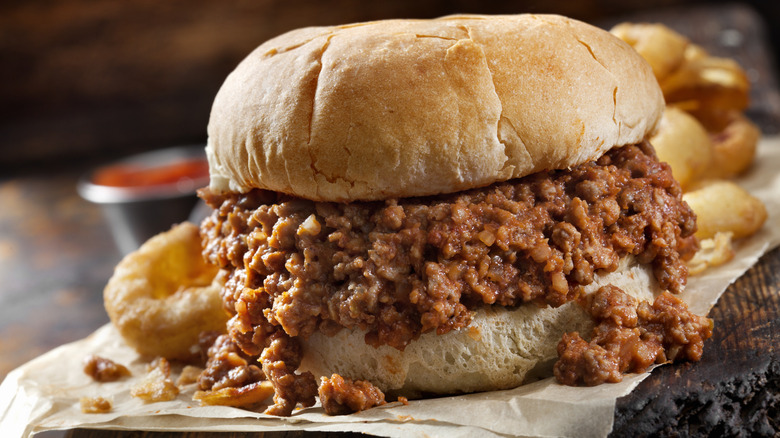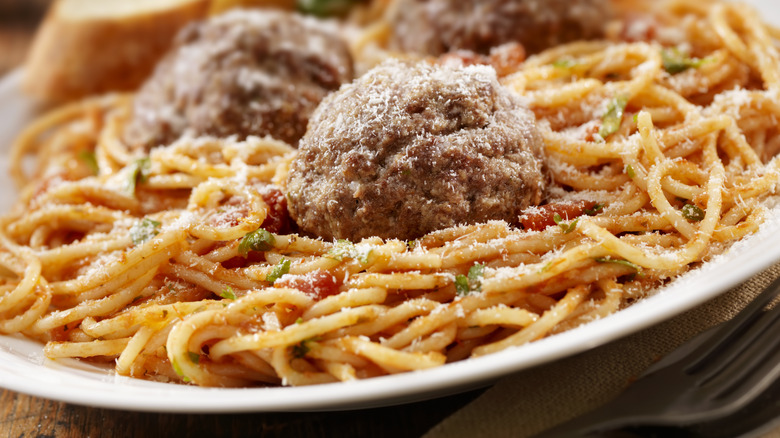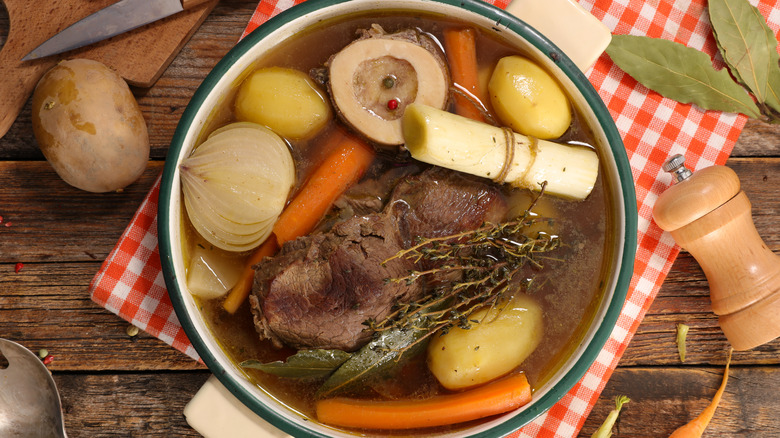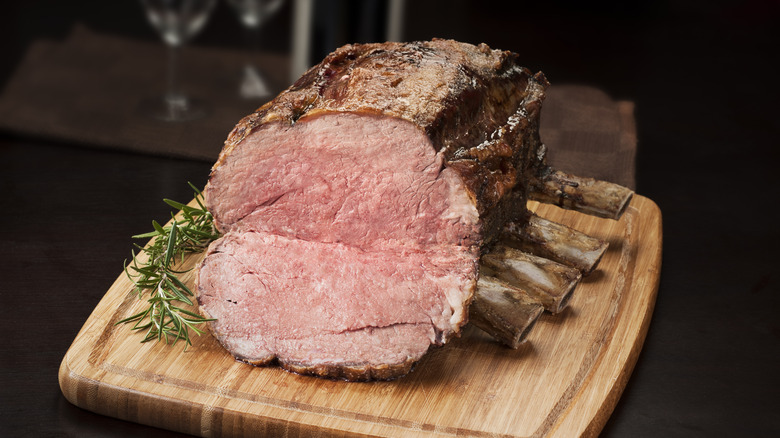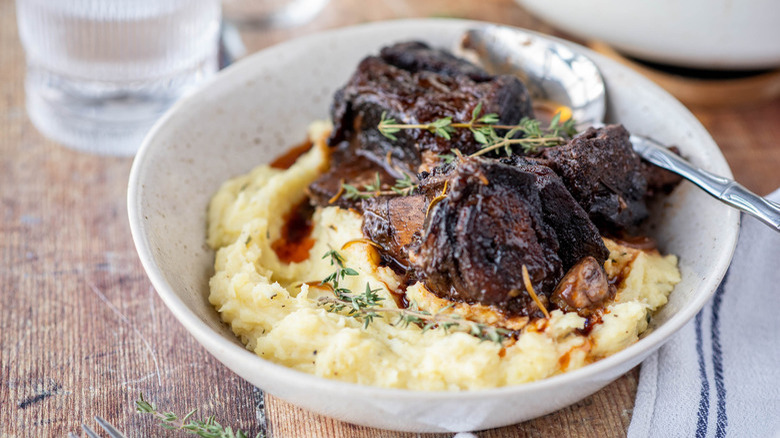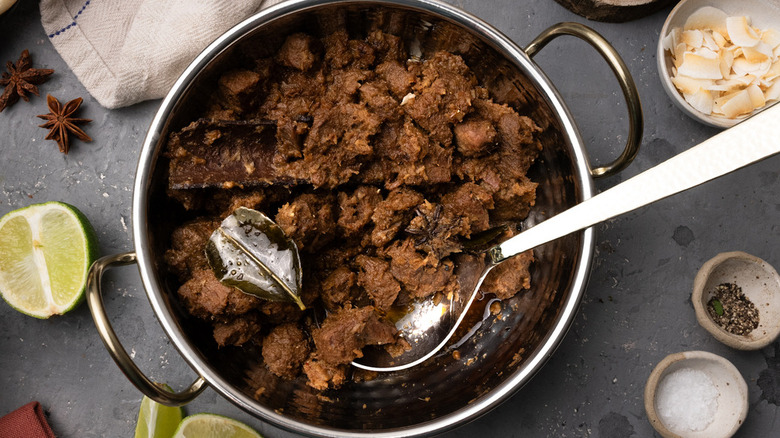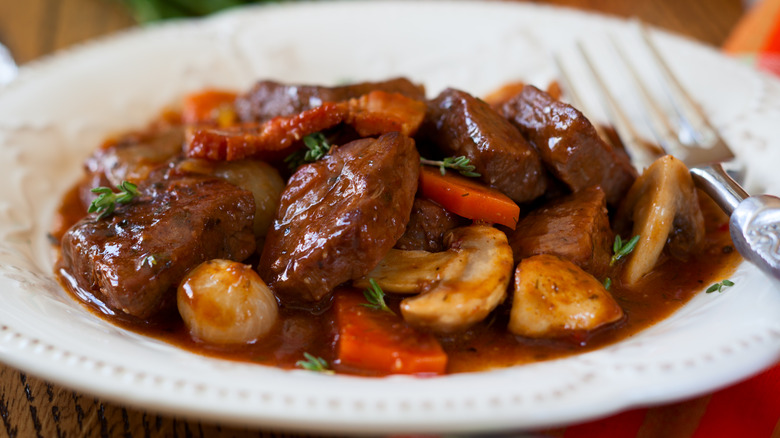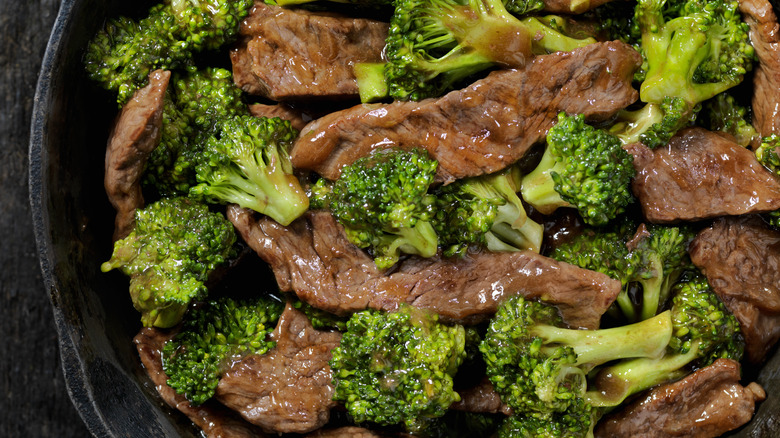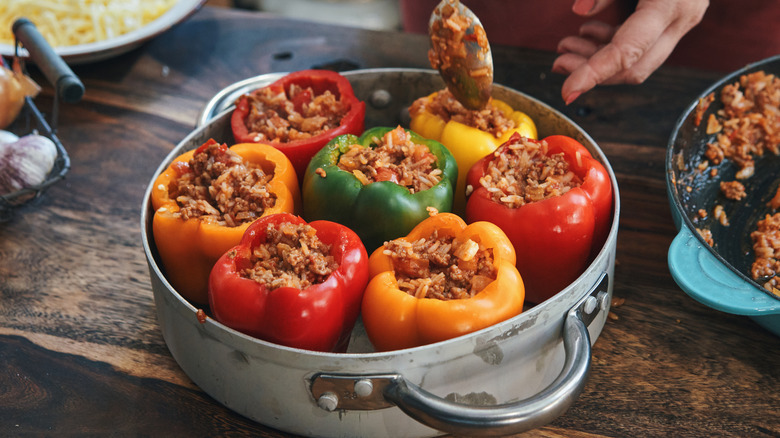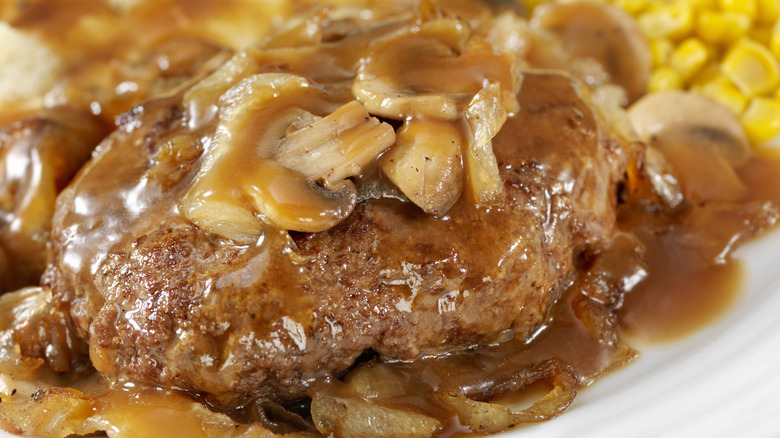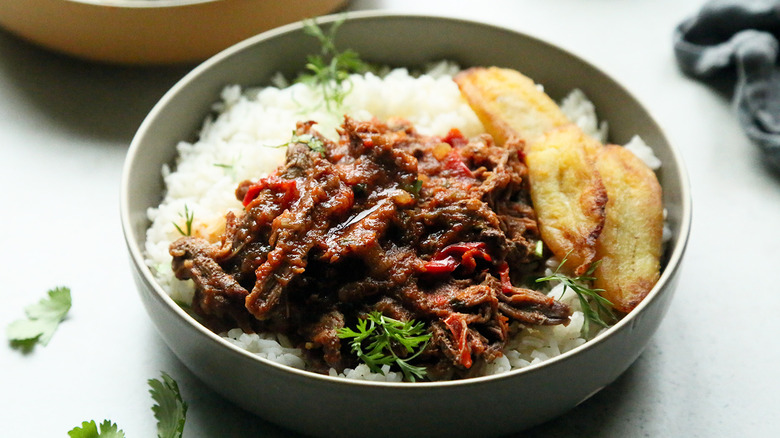20 Classic Beef Dishes Every Home Cook Should Know
There's no denying the prevailing popularity and versatility of beef, which probably explains why it's one of the most widely consumed meats out there. The beauty of beef is that you can cook it just about any way imaginable, and it will taste good — grill it, bake it, sous vide it, pan fry it, even boil it (not that we recommend that option), and you've got a protein-packed main course with little effort.
Another perk of beef is that it is considerably inexpensive; while you could splurge on pricier cuts of filet mignon or pricey Wagyu, cheaper alternatives like ground beef or flank steak prove that this protein can feed a family on a budget. But just because beef is readily available doesn't mean that everyone knows exactly how to cook it or how to incorporate it into delicious recipes ... until now, that is.
If you're looking to beef up your beef recipe repertoire, then a good first step is nailing a handful of classic recipes. Even if beef isn't the top protein in your household, it doesn't hurt to have a go-to meatloaf, burgers, or beef bourguignon recipe on hand so you can get craftier in the kitchen and ensure that dinner will satisfy everyone's taste buds.
Pot roast
Think back to when you were a child — if you came home from school and saw the Crock Pot on the countertop, then there's a good chance that you immediately knew what dish would be on the dinner table. That dish, of course, is none other than pot roast, an American staple (and one often prepared in a slow cooker) that actually has French roots.
There's a lot to love about pot roast, and one of the biggest perks is that it's an all-in-one dish. There are quite a few vegetables that you could include in a pot roast, with some common players including onions, carrots, and potatoes. When you prepare the roast, you don't need to worry about preparing sides — they're built into the dish!
Of course, the star of any good pot roast is the beef, and you shouldn't worry about getting the most expensive cut out there. In fact, it's a good idea to use a tougher cut like beef chuck as the slow-cooking method will lend itself to perfectly tender meat.
Meatloaf
There are fewer beef-centric dishes more classic or comforting than good old meatloaf, and as it turns out, the aptly-named, classic beef dish has quite the history; meatloaf traces back to ancient Rome! Of course, the meatloaf you're familiar with probably comes from a more local source, and by local, we mean grandma's kitchen.
Though meatloaf may not be everyone's cup of tea, there's no denying that it's an easy-to-make, budget-friendly meal that will easily feed the whole family. As long as you avoid common meatloaf mistakes like omitting a binder or overcooking the loaf, then this is exactly the beef dish that should be in your regular dinner rotation — just don't forget the ketchup glaze!
Beef stroganoff
Beef stroganoff is something of a marriage between French and Russian cuisine, though it is ultimately named after a Russian Count and features common Russian ingredients like onion and sour cream. Nowadays, beef stroganoff isn't necessarily the most popular dish, but if you're looking for something ultra-hearty, rich, and nourishing, it can become your dinnertime go-to.
The dish is most recognizable thanks to thick noodles (egg noodles work well) and thinly sliced beef. There's no one cut of beef that works best, so if you're looking for an inventive way to use up that not-so-expensive steak, stroganoff is the solution. And, of course, don't overlook the rich and creamy sauce, which is made possible mostly thanks to that handy sour cream and beef broth.
Chili
There's a good chance that you've enjoyed a bowl of chili at some point in your life, but unless you have a family recipe locked down, then there's an equally good chance that each bowl of chili in your life has been different. Chili, in its most basic sense, is a stew, and one that almost always contains beef and maybe even some beans. That said, there are endless ways that you could customize chili — you could omit the beans, switch up the vegetables, or even take a vegetarian approach and ditch the meat. But if you want to make a true chili con carne, well, you'll need the beef.
Ideal for savoring on chilly winter evenings, chili is the type of dish that is incredibly warm and comforting, just about guaranteed to fill you up. It is worth it to land on a go-to chili recipe as it puts inexpensive ground beef to good use, and it's nearly impossible to whip up a batch of chili that doesn't end up being large enough to feed a crowd.
Beef stew
Beef stew is a general term that could refer to a number of dishes, but as long as yours includes some type of beef, a rich broth, and possibly some carrots or onions, then you've got a stew. Landing on a specific definition of beef stew isn't incredibly important, but something that is quite crucial is making sure that you're boosting the flavor of your stew as much as possible.
If you were to simply cook beef, vegetables, and broth together, it wouldn't taste bad, but it could be pretty bland and boring. There are plenty of ways to add more flavor to beef stew, from expected inclusions like salt and herbs to more oddball (but worthwhile) ingredients like coffee, cinnamon, or bacon. As for the beef itself, aim for a cut of chuck, oxtail, or even bone-in short ribs for the most tender results.
Beef Wellington
When you think of a dish that's considerably high-end or elevated, there's a good chance that beef Wellington might come to mind. The beloved U.K. classic is indeed a masterclass in elevated cuisine, and not necessarily because it incorporates unreasonably expensive or hard-to-source ingredients. You will need a couple of filets if you want to make a beef Wellington worthy of Gordon Ramsay, but otherwise, the beauty of the dish comes down to the method more than anything else.
If you're willing to put forth the effort to make the perfect Wellington — from the medium-rare beef all the way up to the flaky pastry crust — then there's no doubt that it'll be worth the time spent in the kitchen. Save this dish for date nights or special occasions to wow your guests ... and probably wow yourself, too.
Oxtail stew
Oxtail stew is a specific type of beef stew that highlights — you guessed it — oxtail. But what exactly is oxtail? As the name implies, oxtail is a cut that comes from the tail of a cow, and it's not the type of meat you want to cook fast and hot. No, the key to enjoying the true delicacy of oxtail is to cook it low and slow, and luckily, a stew provides just the right setting for such a cooking process to occur.
Like most types of stew, you can't go wrong pairing your oxtail with classic vegetables like onion, carrots, or potatoes. Oxtail is an incredibly flavorful cut of cow to cook with, rich in fat, but you'll want to keep in mind that oxtails are not consistent in their yield, unlike a roast or steak. Still, it is one flavor that will spruce up your dinner routine and ensure that your stew is anything but boring.
Burgers
Is there anything more quintessentially American than a good old burger? As it turns out, probably — burgers actually hail from Hamburg, Germany, but nevertheless, they've become an American staple. It's hard to resist a juicy beef burger, even better when it's piled high with cheese, tomato, lettuce, and onion, and best yet when it's paired with a serving of French fries.
While many people enjoy burgers primarily at restaurants or via the drive-thru lane, it's quite easy to whip up a batch of burgers in your own home, and you really can't go wrong with the cooking method. Grilled, baked, or pan-fried burgers are all great homemade options, and best of all, you can customize your burger with all of the sauces and toppings that your heart desires.
Cottage pie
Perhaps you expected to see shepherd's pie on this list, and if lamb were the protein we were focusing on, then your expectations would be met. Instead, we're talking about beef, so the dish that should be on your radar should actually be cottage pie — yes, the only real difference between the two dishes is the star protein. A traditional shepherd's pie calls for ground lamb, which cottage uses beef.
There's a whole lot to love about cottage pie, especially if you're a fan of ultra-savory, comforting meals. Though you can get creative with your pie filling, you'll typically find beef and an assortment of vegetables at play. Of course, no cottage pie filling would be complete without the layer of mashed potatoes slathered on top, which also conveniently makes this a whole meal packed succinctly into one baking dish.
Sloppy Joe
Though you might not guess it from an unassuming sandwich, the Sloppy Joe sandwich has something of a controversial origin story. Or perhaps we should say stories since there are three variations of where the notoriously messy sandwich was first made. It's possible that the Sloppy Joe originated in Iowa, whereas others say it hails from Florida, and others say it actually got its start in a bar in Cuba. Will we ever know the truth of the Sloppy Joe's origin?
Sure, you could buy canned Manwich meat if you wanted to make homemade Sloppy Joes, but you could also make a from-scratch Joe with very little fuss. As it turns out, a mixture of ground sirloin and chuck beef is key to a mouth-watering Sloppy Joe, and a big plus to these sandwiches is that no toppings are necessary — the big heap of meat will speak for itself.
Spaghetti and meatballs
Is there anything better than a big, heaping plate of spaghetti and meatballs? If you answered that question with a resounding "no," then it only makes sense that you enjoy spaghetti and meatballs as often as possible. To do so, you should probably venture outside of ordering the dish while dining out and master the meaty pasta favorite in your own kitchen. Do you need to make the pasta from scratch? No, store-bought will work just fine, and you could even use store-bought sauce to keep things nice and simple. If there's one component of the dish that you should absolutely make from scratch, however, it would be the meatballs.
Though you could use other types of meat to make meatballs, beef is a classic option that will yield tender, juicy results every time. To add flavor to your meatballs, use dried herbs, Parmesan cheese, or even unsweetened applesauce to help retain moisture. Whatever way you whip up your meatballs, there's no denying their rightful spot atop a pile of pasta.
Pot-au-feu
Fans of classic French cuisine have no doubt heard of pot-au-feu, and perhaps you've even enjoyed the comforting, savory dish for yourself. Translating from French to aptly mean "pot on fire," pot-au-feu looks a lot like a classic beef stew in that it features broth, vegetables, and of course, some type of beef. In this case, often multiple cuts. While the type of beef you opt to use comes down to personal taste, good options include brisket, chuck roast, or oxtail — all cuts that benefit from a low and slow cooking method.
An interesting thing about pot-au-feu is that while many types of beef stew are eaten in one serving, this French dish is typically served in multiple courses. First, you enjoy a bowl of rich and savory broth; then you move on to the meat of the dish. Of course, when you whip up a batch of pot-au-feu in your own kitchen, you can serve it in as many or as few courses as you'd like.
Prime rib
While many people opt for turkey or ham as star proteins during the holidays, there's one beef option that presents with just as much elegance: prime rib. As the name suggests, prime rib comes from the ribcage area of a cow, and due to its bone-in appearance, it's sometimes referred to as a standing rib roast. Regardless of what you call it, there's no denying that a perfectly cooked, medium-rare prime rib is a true delicacy comparable to a rack of ribs or Thanksgiving turkey.
If you want to get creative with a date night meal or impress with beef for the holidays, then prime rib is the way to go. The good news about this remarkable dish is that it's quite easy to cook; oven baking is the easiest method, and you're best off using a digital meat thermometer to ensure that you don't overcook the meat.
Braised short ribs
It's no surprise that short ribs come from the rib section of a cow, but a more specific name for such a cut would be chuck short ribs. Like so many beef cuts, short ribs are best enjoyed after a period of slow cooking — patience is key when it comes to making short ribs, but the results are very much worth it.
A common cooking method associated with short ribs is braising, which means that you'd sear the beef first, then you'd cook it in liquid for a long period of time, usually a few hours. Searing the meat helps lock in the flavor, whereas slow cooking helps ensure that the insides end up perfectly tender and incredibly juicy. It's common to braise short ribs in wine, though stock (or a combination of both) also gets the job done.
Beef rendang
If you've heard of beef rendang, then you might recognize it as having origins in Indonesia or Malaysia. The dish technically originated in West Sumatra, Indonesia, but nowadays, there are a few South Asian countries that retain claims on the coconut milk-braised beef dish. Luckily, there's plenty of beef rendang to go around, and while you would no doubt find the tastiest variation of the dish if you traveled through South Asia, you can make a version that's pretty good right at home.
The key to making beef rendang doesn't necessarily lie in any particular ingredient, but instead in the method, which calls for cooking beef nice and slow in a seasoned coconut milk mixture. The result is an incredibly soft and moist meat that pairs well with rice but can certainly be enjoyed all on its own.
Beef bourguignon
Beef bourguignon is yet another example of beef stew, but one that is definitively French down to its origins in Burgundy. The biggest difference between bourguignon and any old beef stew is that the former includes red wine — ideally Burgundy wine, but even if you can't swing such an inclusion in your dish, we think it still counts as the real deal.
The beauty of beef bourguignon is that, much like other stews, it's a well-balanced meal conveniently built into one package. You've got the wine-braised beef, you've got vegetables, you've got a rich, meaty sauce — and if you serve this up at a dinner party, you've got bragging rights, too. Fans of mushrooms will also love this one, as you'll find the fungi as a staple ingredient in this fine French creation.
Beef and broccoli
Many dishes that an American might consider to be traditional Chinese cuisine are actually just inauthentic American recreations (looking at you, crab rangoon) or at least Chinese-American fusion. Beef and broccoli, as it turns out, teeter that same line. While it was most likely brought to the States by Chinese immigrants, the dish we ultimately know and love in America is one that has been contrived over the decades.
If you've ever enjoyed beef and broccoli, be it a homemade version or takeout, then you understand that there really is a lot to love in the dish. On the surface, it seems so simple — it's just beef and broccoli! — but there is much more flavor to behold. The thinly sliced flank steak contrasts nicely with the slightly bitter broccoli, and combined with a sweet and salty, tangy sauce, this is one simple dish that's anything but boring.
Stuffed peppers
For those who just never know what to do with bell peppers, let stuffed peppers revolutionize your dinnertime routine. What better way to make use of a whole bell pepper than to stuff it with meat and rice? Though you can switch up the type of meat that you use, ground beef is the most classic option, and it certainly delivers savory results time and time again.
There's something inherently comforting about a stuffed pepper, and there's also a good amount of wiggle room to get creative with toppings. Go all-out and dollop on sour cream and a big scoop of cheese, or be so bold as to dive right in sans toppings and enjoy the vegetal flavor of pepper encompassing your stuff, making a simple but delicious dish.
Salisbury steak
Salisbury steak is an all-American dish that has historic connections to the Civil War. The dish is named after Dr. James Henry Salisbury, and his solution to treating ailing soldiers during the war was to feed them a diet of minced meat and ... well, just that. While we can't attest to a diet consisting only of meat, we can attest to the long-lasting legacy of Salisbury steak and the way it has become more of a comfort meal over the years than a struggle one.
Nowadays, Salisbury steak might not be the most expensive or impressive option on the menu, but it is one that will satisfy, especially if it's paired with mashed potatoes. Unlike the Civil War days, modern-day Salisbury steak isn't made up of a variation of minced meat; it's made from ground beef, and if you make a homemade version, be sure to top it off with a savory mushroom gravy.
Ropa vieja
Though ropa vieja is considered a classic Cuban dish through and through, it does technically have roots in Spain. And, anyone familiar with Spanish might recognize ropa vieja to translate to "old clothes," which is quite the apt name for a dish that features a heaping pile of shredded beef.
Ropa vieja is typically served alongside rice or beans, though there's no denying that the beef itself is the star of the show. Flank steak or beef chuck are both good options, though it really comes down to the slow braising method of cooking that turns these old clothes into something quite spectacular.
